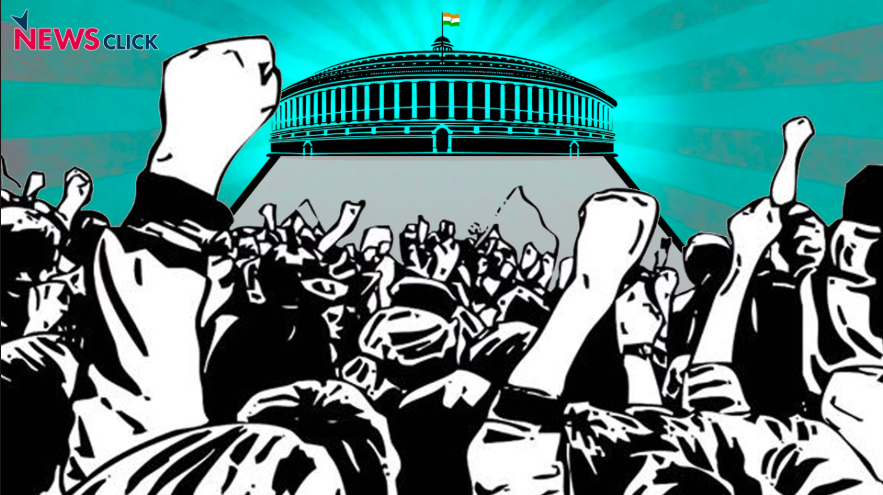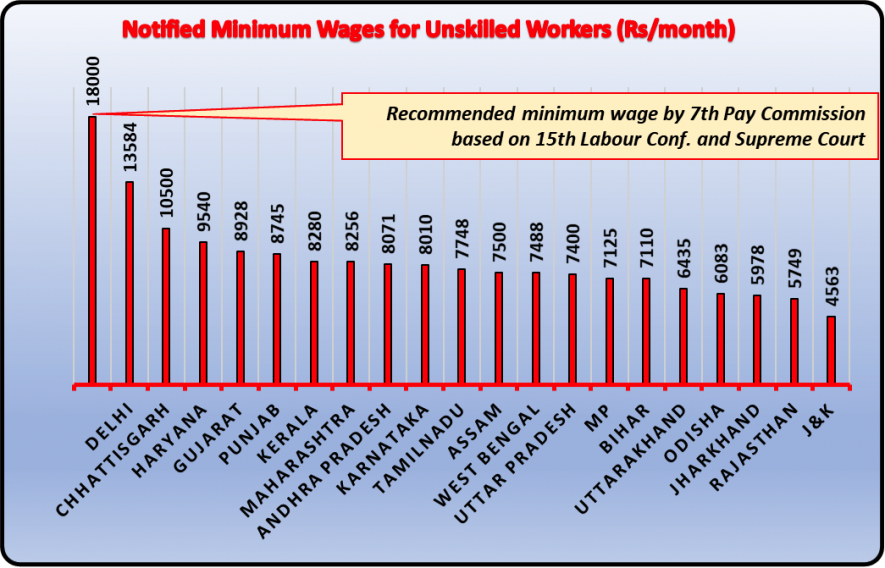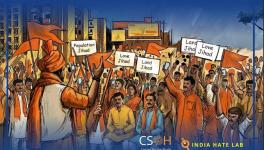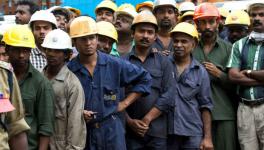#WorkersStrikeBack: Why Are Workers Striking for Better Wages?

One of the key demands driving millions of workers to prepare for a two-day strike on January 8-9, 2019 is better wages. Have a look at the chart below which summarises the notified minimum wages in major states and compares it with the minimum needed by a family of four (two adults and two children). Remember: these are ‘notified’ or ‘statutory’ wages, declared by state governments, as required by the minimum wage laws. Most workers get even less than this.

You can see that, barring a couple of states, even the notified wage is less than half of what would be the minimum requirement of Rs.18,000 per month.
How is this minimum requirement worked out? There is a well-accepted formula for this based on consumption of various food items, and costs of other essentials, such as clothes, fuel, transport etc. This formula was worked out long ago by assuming that an adult needs at least 2,700 kcal of energy per day for living (and doing moderate level of work), and also, that this adult worker will have a family to sustain. The whole calculation is very neatly explained in the 7th Pay Commission Report (See pages 62-65).
So, the 7th Pay Commission, a government-appointed statutory body, approves and recommends that the minimum wage needed today is Rs.18,000 per month. This is for a no-frills existence – there is barely anything to take care of good education (which is expensive) or good healthcare (which is even more prohibitive), forget about leisure or vacations or entertainment.
In short, this Rs.18,000 is just enough to keep the hapless family alive. This is what the workers are demanding.
In 1992, the Supreme Court had observed in a matter that at least 25% more should be added to the calorific intake-cum-essential needs calculation to account for education, health, recreation etc. The 7th Pay Commission has adjusted this through other ways.
In reality, the vast majority of industrial workers and employees in the service sector are not getting even this statutory wage. Employers adopt a thousand creative ways to give them less. Some of the more common ways include: making people work for more than the 8-hour work shift (say, for 12 hours) but not pay them overtime wages; coerce workers to sign up on more on the wage register while giving them less; making arbitrary cuts in wages based on leaves taken, etc. Invariably, women are payed less than men.
One of the most common ways of escaping the notified wage is contract work. This heinous system has been institutionalised by the Modi government in the form of ‘fixed term employment’. A contractor is paid by the company to deploy the workers/employees and wage payment is made to him. He in turn pays much less to the workers. Such workers not only get less wages, they are deprived of various other legal benefits like paid leave, bonus, etc.
The bottomline is that workers are forced to work on very low wages, while the employer accumulates enormous profits based on this unpaid labour.
A natural question would be: if wages are so exploitative, why do workers accept to work at all? Why not go elsewhere or do something else?
That’s impossible because you can’t escape the grinding stones of this predatory exploitation. Everywhere the system is same. And, because industry in general is not expanding, there are no new job opportunities. Meanwhile, the agrarian crisis is driving more and more people in search of jobs. There is a standing army of unemployed outside factory gates and this drives down wages, keeps workers submissive and unprotesting.
Under the Narendra Modi regime, two country-wide strikes have already taken place in the last four-and-a-half years on this issue, besides dozens of marches, dharnas, sectoral agitations, state-wide protests, jail bharo movements and what not. Yet the “sabka saath, sabka vikas” sarkar is untroubled by this growing anger.
The coming strike, months before the general election, is a final push by the workers to the current ruling party – and a warning to any future ones.
Get the latest reports & analysis with people's perspective on Protests, movements & deep analytical videos, discussions of the current affairs in your Telegram app. Subscribe to NewsClick's Telegram channel & get Real-Time updates on stories, as they get published on our website.
























